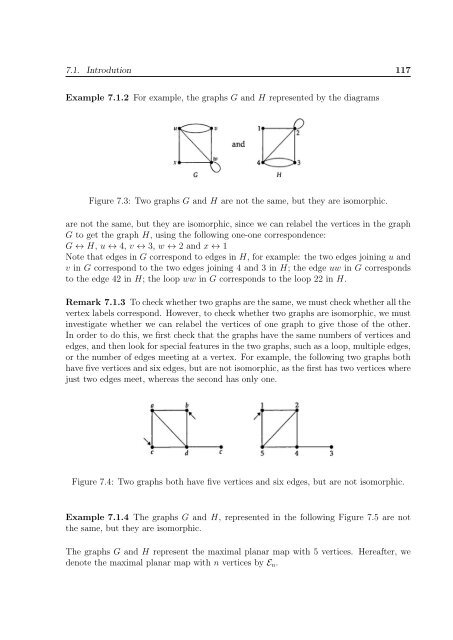enumeration of the number of spanning trees in some ... - Toubkal
enumeration of the number of spanning trees in some ... - Toubkal
enumeration of the number of spanning trees in some ... - Toubkal
Create successful ePaper yourself
Turn your PDF publications into a flip-book with our unique Google optimized e-Paper software.
7.1. Introdution 117Example 7.1.2 For example, <strong>the</strong> graphs G and H represented by <strong>the</strong> diagramsFigure 7.3: Two graphs G and H are not <strong>the</strong> same, but <strong>the</strong>y are isomorphic.are not <strong>the</strong> same, but <strong>the</strong>y are isomorphic, s<strong>in</strong>ce we can relabel <strong>the</strong> vertices <strong>in</strong> <strong>the</strong> graphG to get <strong>the</strong> graph H, us<strong>in</strong>g <strong>the</strong> follow<strong>in</strong>g one-one correspondence:G ↔ H, u ↔ 4, v ↔ 3, w ↔ 2 and x ↔ 1Note that edges <strong>in</strong> G correspond to edges <strong>in</strong> H, for example: <strong>the</strong> two edges jo<strong>in</strong><strong>in</strong>g u andv <strong>in</strong> G correspond to <strong>the</strong> two edges jo<strong>in</strong><strong>in</strong>g 4 and 3 <strong>in</strong> H; <strong>the</strong> edge uw <strong>in</strong> G correspondsto <strong>the</strong> edge 42 <strong>in</strong> H; <strong>the</strong> loop ww <strong>in</strong> G corresponds to <strong>the</strong> loop 22 <strong>in</strong> H.Remark 7.1.3 To check whe<strong>the</strong>r two graphs are <strong>the</strong> same, we must check whe<strong>the</strong>r all <strong>the</strong>vertex labels correspond. However, to check whe<strong>the</strong>r two graphs are isomorphic, we must<strong>in</strong>vestigate whe<strong>the</strong>r we can relabel <strong>the</strong> vertices <strong>of</strong> one graph to give those <strong>of</strong> <strong>the</strong> o<strong>the</strong>r.In order to do this, we first check that <strong>the</strong> graphs have <strong>the</strong> same <strong>number</strong>s <strong>of</strong> vertices andedges, and <strong>the</strong>n look for special features <strong>in</strong> <strong>the</strong> two graphs, such as a loop, multiple edges,or <strong>the</strong> <strong>number</strong> <strong>of</strong> edges meet<strong>in</strong>g at a vertex. For example, <strong>the</strong> follow<strong>in</strong>g two graphs bothhave five vertices and six edges, but are not isomorphic, as <strong>the</strong> first has two vertices wherejust two edges meet, whereas <strong>the</strong> second has only one.Figure 7.4: Two graphs both have five vertices and six edges, but are not isomorphic.Example 7.1.4 The graphs G and H, represented <strong>in</strong> <strong>the</strong> follow<strong>in</strong>g Figure 7.5 are not<strong>the</strong> same, but <strong>the</strong>y are isomorphic.The graphs G and H represent <strong>the</strong> maximal planar map with 5 vertices. Hereafter, wedenote <strong>the</strong> maximal planar map with n vertices by E n .

















